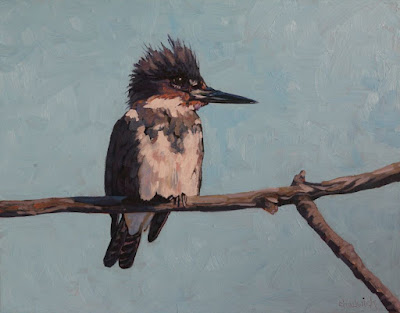 |
#2854 "Eastern Meadowlark"
14x18 inches oils on canvas
Started April 19th, 2024 |
Sadly, I rarely see a meadowlark anymore within the Singleton Sanctuary. We maintain a mix of forest and open pasture. The grasses are only cut after nature has had time to nest and raise their young. The habitat is near perfect and undisturbed but perhaps other forces are at work.
This image by my friend John Verburg highlights how beautiful these birds are. Their song is enough to make them a vital component of the landscape.
The Eastern Meadowlark is a medium-sized, migratory songbird (about 22 to 28 centimetres long) with a bright yellow throat and belly, a black "V" on its breast and white flanks with black streaks. Their backs are mainly brown with black streaks. They have pinkish legs, a long, pointed bill and a light brown and black striped head. The Eastern Meadowlark's song is composed of a series of two to eight clear, flutelike whistles, often slurred together and descending in pitch.
Eastern Meadowlarks walk on the ground, often concealed by grasses or crops. Males sing beautiful, flutelike songs from exposed perches, particularly fenceposts. Their flight is a distinctive sequence of rapid fluttering and short glides, usually low to the ground. In winter you may see flocks of meadowlarks hunting insects in fields.
Eastern Meadowlarks live in farm fields, grasslands, and wet fields. They nest on the ground and sing from exposed perches such as treetops, fenceposts, and utility lines.
Eastern Meadowlarks are a declining species. Populations fell approximately 2.6% per year between 1966 and 2019, resulting in a cumulative decline of 75%, according to the North American Breeding Bird Survey. If the decline in their population continues, their numbers will be halved in less than 20 years. Partners in Flight estimates a global breeding population of 37 million and rates them 11 out of 20 on the Continental Concern Score. Eastern Meadowlarks are listed as a Common Bird in Steep Decline for species that are still too numerous or widely distributed to warrant Watch List status but have been experiencing troubling long-term declines.
Losses are due to disappearing grassland habitat. Prairie is scarce in the eastern United States, and the kinds of farms that once hosted meadowlarks—small, family farms with pastureland and grassy fields—are being replaced by larger, row-cropping agricultural operations or by development. Early mowing, overgrazing by livestock, and the use of pesticides can also harm meadowlarks nesting on private lands. Farmland conservation practices are vital to the survival of this species.
Eastern Meadowlarks are also subject to predators, including foxes, domestic cats and dogs, coyotes, snakes, skunks, raccoons and other small mammals. In Ontario, the number of Eastern Meadowlarks has decreased by almost 65 percent during the past 40 years.
"Threatened" means the species lives in the wild in Ontario, is not endangered, but is likely to become endangered if steps are not taken to address factors threatening it. The meadowlark was added to the Species at Risk in Ontario List on January 13, 2012. Threatened Species and their general habitat are automatically protected
I use these art posts to also relearn or discover for the first time, some natural history facts about the world around us. It is more of a challenge to assist and preserve something that one does not understand or appreciate. Thank you for reading this far... Education is a way of life and may it never get old.
For this and much more art, click on Pixels or go straight to the Collections. Here is the new Wet Paint 2024 Collection.
Warmest regards and keep your paddle in the water,
Phil Chadwick





































